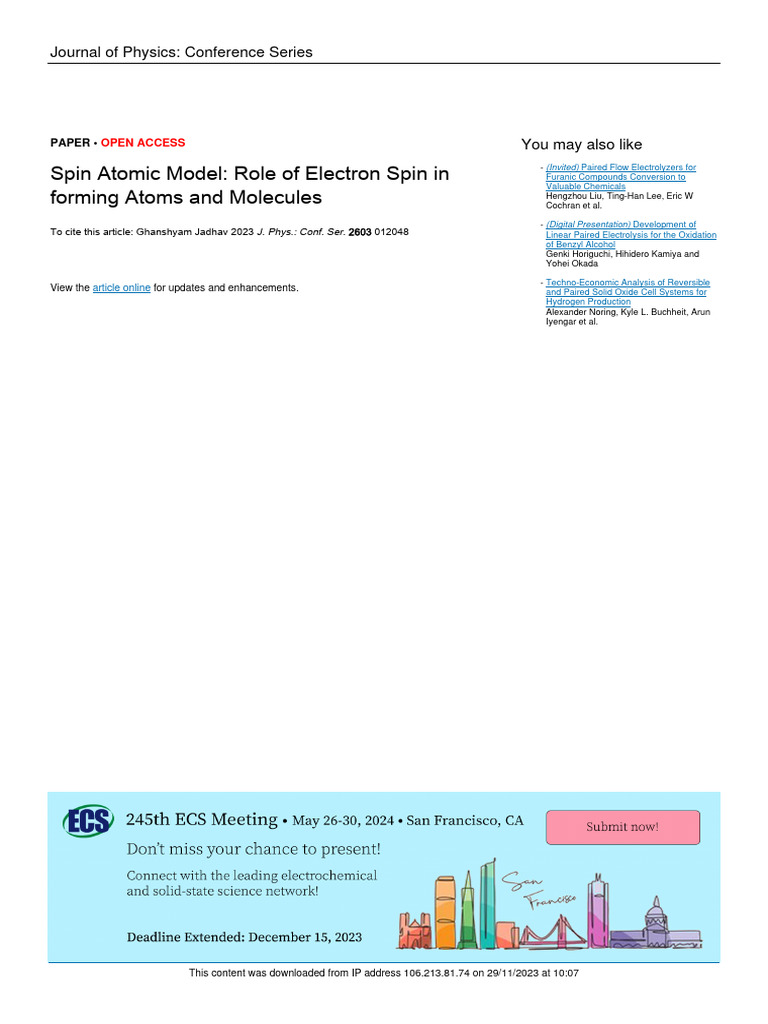In the intricate tapestry of atomic theory, the concept of spin emerges as a fascinating yet enigmatic attribute of subatomic particles. It fundamentally alters our comprehension of atomic interactions, chemical bonding, and the underlying principles of quantum mechanics. To delve into this captivating subject, this article will explore the notion of spin as it pertains specifically to the particles of atoms, particularly the electron, and the implications it holds for our understanding of the atomic structure.
The atom is predominantly composed of three types of subatomic particles: protons, neutrons, and electrons. Among these, spin is a property most famously associated with electrons. When discussing the characteristics of electrons, it becomes imperative to consider their intrinsic angular momentum—a concept that deviates from classical physics notions of motion. Spin is defined as a fundamental property of particles, akin to charge or mass, and it has vast consequences on the behavior of electrons within an atom.
To elucidate the principal association between spin and electrons, one must first grasp the quantum mechanical framework that governs atomic behavior. In quantum mechanics, particles do not behave like classical objects in fixed trajectories. Instead, they exist in superpositions of states, which means that their characteristics can only be described probabilistically. Spin is quantized, and for electrons, it can take on one of two values, conventionally termed as “spin-up” or “spin-down.” The representation of these states is often visualized using quantum states or spinors, and collectively, they serve as building blocks for considering more complex systems.
Importantly, the implications of electron spin extend far beyond static atomic theory; they influence numerous phenomena across various realms of physics and chemistry. One such phenomenon is the Pauli Exclusion Principle, which states that no two electrons in an atom can occupy the same quantum state simultaneously. This principal rule arises directly from the antisymmetric nature of wave functions for fermions (a class of particles that includes electrons). The exclusion principle plays a critical role in determining the electronic structure of atoms and, consequently, the chemical properties of elements.
Furthermore, electron spin contributes to the anatomy of chemical bonding. When atoms combine to form molecules, their electrons often engage in pairings that are influenced by their respective spins. For instance, covalent bonds arise when electron pairs occupy the same orbital, necessitating opposite spins as a prerequisite for stability. This bipartite nature fosters the idea that the elemental interactions occurring at the atomic level are governed, to a significant extent, by nuanced parameters of electron spin.
Yet, the narrative of spin does not end with electrons; it resonates throughout the atom’s core as well. While protons and neutrons possess spin, their respective contributions to the atomic spin system manifest differently than that of electrons. Protons, as baryons, similarly exhibit an intrinsic spin of one-half, while neutrons, being neutral particles, also possess a spin of one-half. Collectively, the spin of protons and neutrons contributes to the nucleus’s overall angular momentum. However, it is crucial to emphasize that the characteristics of nucleon spin and their bonding scenarios differ from those prevalent in electron behavior.
The exploration of spin phenomena expands our understanding through applications in various fields, including magnetic resonance imaging (MRI), quantum computing, and spintronics. Each of these domains exploits the unique properties of electron spin—transforming it from a hypothetical concept into practical applications that revolutionize technology and medicine. For instance, in MRI, the manipulation of spins in the presence of a magnetic field facilitates high-resolution imaging of soft tissues, demonstrating how quantum mechanics can translate into tangible advancements in healthcare.
In addition, the burgeoning field of quantum computing relies heavily on the principles of spin to encode information. Quantum bits, or qubits, can exist in superpositions of spin states, offering computational capabilities that far surpass classical bits. As researchers strive to harness electron spin for data processing, the potential for innovation appears limitless.
Moreover, spintronics, a novel area emerging at the intersection of spin physics and electronics, seeks to exploit the electron’s spin degree of freedom alongside its charge. By integrating spin as an essential component of electronic devices, researchers envision devices with enhanced functionality, reduced power consumption, and increased speed, heralding a new era of information technology fueled by quantum mechanics.
The intricate relationship between spin, particularly in electrons, and atomic structure unveils a kaleidoscopic view of contemporary physics. From the implications surrounding the Pauli Exclusion Principle to applications in cutting-edge technology, understanding spin not only broadens our intellectual horizons but also challenges ingrained perceptions of the atomic world. As science advances, the exploration of these fundamental principles will continue to carve paradigms that shift our perspective on reality, providing endless opportunities for inquiry and innovation.
In conclusion, while the notion of spin is quintessentially linked to electrons, its ramifications permeate all facets of atomic structure and interact with broader fields of study. Embracing the complexities of spin will not only enhance our understanding of basic atomic interactions but also empower future technologies. The quantum realm beckons with its mysterious wonders, urging us to redefine our perceptions of particles and their elegant dance within the atom.












